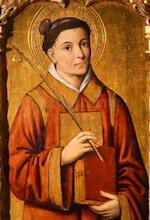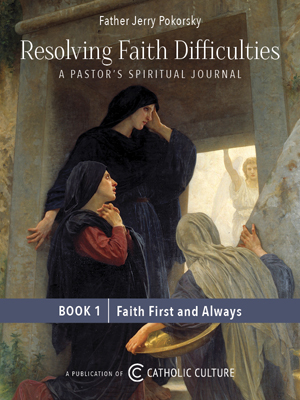Catholic Activity: Blessed Palms in the Home
The procession at Mass with the palms was a public display of homage and loyalty to Christ our King and Redeemer. Christ is the King of our home, so we should incorporate the blessed palms and a family prayer service as part of this day.
Palm trees aren't readily available in some vicinities, there are other plants like olive branches, box, yew, spruce, willows and pussy-willows that are blessed and used the same way as palms for Passion Sunday.
DIRECTIONS
Reverence for Blessed Palms
Because the palms are blessed, they are now sacramentals, which "are sacred signs instituted by the Church. They prepare [us] to receive the fruit of the sacraments and sanctify different circumstances of life" (Catechism of the Catholic Church, 1667). Sacramentals should be treated with respect and never be thrown away. Palms may only be burned or buried.
It is an old tradition to burn blessed palm branches in times of forthcoming natural disasters, such as hurricanes or tornadoes, asking God to avert or lessen the impending disaster. The instruction in the Directory on Popular Piety explains why this practice is not encouraged:
The faithful, however, should be instructed as to the meaning of this celebration so that they might grasp its significance. They should be opportunely reminded that the important thing is participation at the procession and not only the obtaining of palm or olive branches. Palms or olive branches should not be kept as amulets, or for therapeutic or magical reasons to dispel evil spirits or to prevent the damage these cause in the fields or in the homes, all of which can assume a certain superstitious guise.
Palms and olive branches are kept in the home as a witness to faith in Jesus Christ, the messianic king, and in his Paschal Victory."
Keeping in mind the symbolism of the palms, and that they are blessed, here are some suggestions in using the palms at home:
Palm Crosses
After Mass on Palm Sunday, family members can gather the palms and make a small palm cross to wear. There are a variety of ways to make the cross. The simplest is to take two small pieces, one a little longer than the other, crisscross the pieces in shape of a cross and staple at the middle. Another way is to make two small slits near the top (where the crossbeam would be) in the longer piece of palm and slide the cross beam through the slits. This could be a challenging project for the family members to try various methods.
Each person is given a palm cross to wear on their coats or clothing throughout Holy Week, to remind us to carry our cross patiently so we may share Christ's Easter glory.
Prayer Service
The family then gathers together. The father reads the account of the entry of Jesus into Jerusalem (from the Gospel of Mark 11:1-10 or Matt 21:1-11 or John 12:12-16 or Luke 19:28-40). Then the mother, with a lighted candle, leads the procession through all the rooms of the house. All sing the hymn All Glory, Laud and Honor and place a palm cross either above the door in each room, or behind the crucifix.
Palm Weaving
Palm Weaving is a tradition found in many countries, such as Italy, Philippines, and Poland. Here are some links for instructions, from the simple cross to the elaborate flowers. Since the palms are blessed, there must be a reverence used towards the sacramental.
- Palm Weaving: The Story… and The Art By Sister Cecilia Schmitt, EdD OSF
- Palm Weaving by Anthony Parente
- Palm Weaving at Origami Resource Center
- Six Ways to Weave Palms from Palm Sunday
- The Tradition of Woven Palms at the Vatican
- Holy Week in the Philippines
Activity Source: Original Text (JGM) by Jennifer Gregory Miller, © Copyright 2003-2025 by Jennifer Gregory Miller






